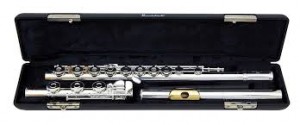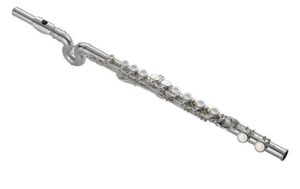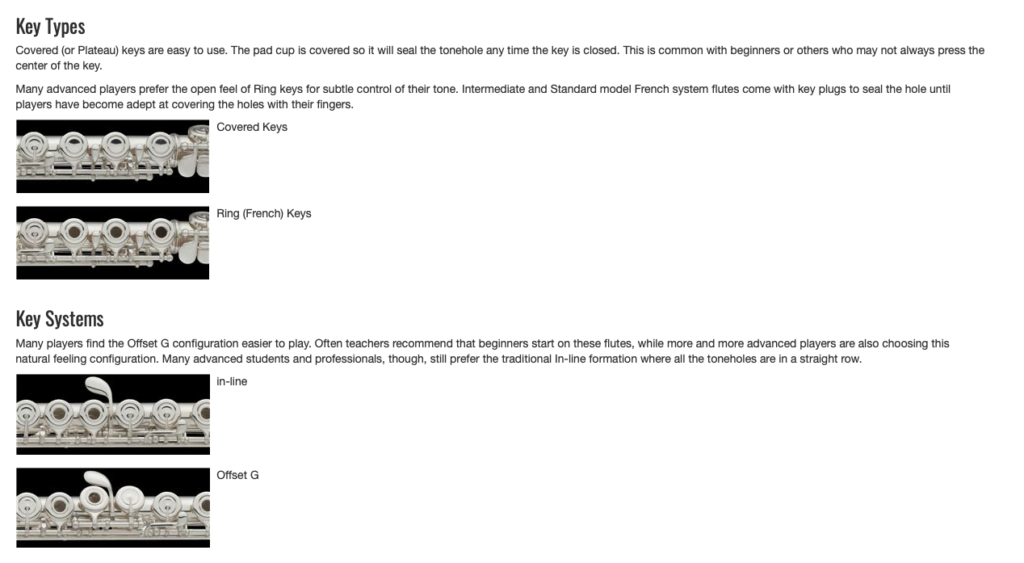New Flute Buying Guide
New Flute Buying Guide
Buying a new flute is a huge decision and a big investment. The blog article below can help you with some common questions.
Flute shoppers are usually of three types:
- Beginner students buying their first flute for band or lessons

- Flutists needing a step-up flute or a second flute.
- Intermediate-advanced students who are shopping for a piccolo.
Each of these purcheses will have different considerations. In this article, we will discuss the beginner or student-model flutes. Future blog posts will discuss step-up flutes and piccolos.
The first flute: “A Beginner or Student-Model Flute”
Regular or Modified Headjoint
The first decision when buying a flute will be whether or not you need a “curved headjoint.” As a general rule, the younger the student, the more likely s/he will need a curved headjoint. Most of my students who start lessons before the age of 8 are most comfortable with the curved headjoint. Their arms are simply not long enough to stretch and hold the regular flute. In the picture below, my daughter, who was 6 years old, is playing with a curved headjoint.
Some beginner flutes will have both a curved and straight headjoint in the same case. This picture shows my daughter’s Trevor James flute with both curved and straight headjoints in the case.
Some brands and model numbers of flutes with curved headjoints:
- Yamaha 200 series – headjoint is sold separately
- Trevor James 10XC2
- Gemeinhardt 2SPCH
- Nuvo – Jflute and optional curved head sold separately
- Jupiter “waveline” 510ES
Material Type
Most beginner flutes will be made of a brass alloy coated with either silver or nickel. I prefer silver because it is shinier and easier to hold, but nickel is cheaper. Nickel finishes have a slippery feel and are darker than silver, but they do not tarnish in the same way as silver. Regardless of the exterior plating. to keep the price low, manufacturers will use a metal alloy throughout the flute, including the headjoint, keys, and mechanism. More expensive flutes will have more solid silver parts.
Two manufactures – Guo and Nuvo – are offering flutes made out of plastic. The tone is noticeably less rich than a metal flute, but they have the advantage of being undamaged by water. To me, the Nuvo flutes feel strange in the mechanism and the pads are squishy, but the Guo flutes are quite impressive. The Guo flutes are much more expensive, however.
Keys
For beginners, covered keys are the easiest. Manufacturers will call these “closed” or “plateau.”
The best key system for beginners and anyone with small hands is “offset G.” This keeps the fingers in a more ergonomic position. It adds some weight to the mechanism, but the benefits far outweigh this minor inconvenience. Most professional flutists that I know play with “offset G.” It’s not a dealbreaker if the flute you love is “in-line” because there are ways to work around this, but all other things being equal, get the offset model.
Other modifications:
Split-E Mechanism– this is being offered on some student model flutes. It facilitates the playing of some intervals on the flute. I don’t think it’s necessary on a student model flute, but it is helpful. The downside is that this adds extra weight and one more place of adjustment on the flute.
Low B footjoint– most student flutes will have a “Low C” footjoint, which means that the lowest note it can play is middle C. Intermediate and professional flutes will almost always have one extra key and they can play one note lower. Most young students will never have to play a low B and the extra weight at the end of the flute can make it that much more difficult to hold the flute. The “C footjoint” is advisable for most beginner players.
Gold plating– some student model flutes will have gold plating on the lip plate or crown, but this is cosmetic and doesn’t do anything for the tone of the flute. Unless you are allergic to silver, there is no compelling reason to pay more for a gold lip plate.
Really Cheap Flutes
Recently, some inexpensive flutes have come on the market. These are being sold on Amazon for as little as $55.88 (as of Jan. 2019.) Manufactured in China, these flutes may or may not be delivered in playable condition. I have had a couple of students purchase these flutes and have been discouraged when they go out of adjustment. The general consensus is that these flutes are not repairable. You will have to throw them away as soon as something goes wrong with the mechanism or they need new pads.
Here are two videos about these cheap Chinese-made flutes purchased on Amazon:
One thing to keep in mind is that these flutes will have zero resale value. If you purchased a new or used flute from an established manufacturer, they will be able to be re-sold at some point in the future. Indeed, many of my students get their first flutes used from a friend, relative, Ebay, Craigslist or Facebook selling wall. The following list includes the brands I trust for beginner students:
Favorite: Yamaha, Trevor James, Guo, Amadeus
Recommended: Gemeinhardt, Jupiter, Pearl, Di Zhao, Azumi
Try before you buy: Armstrong, Selmer, Nuovo, Selmer, Bundy
A Final Word
Whenever possible, play a flute before you buy it. Involve a teacher or flutist. Many teachers enjoy helping their students (I know I do!) and want them to have the best flute they can afford. Be wary of deals that seem too good to be true.
When it’s time to upgrade your flute, check out my blog posts on intermediate flutes and piccolos.
Leave a Reply Cancel reply
You must be logged in to post a comment.
BLOG
- One Grown and Flown September 5, 2023
- Online Music Lessons: One Year And Counting March 25, 2021
- Breathing for Flutists, According to Arnold Jacobs October 31, 2020
- Music Video Projects: Music in the Time of COVID September 30, 2020
- Flutes in Quarantine: Pandemic Safety Part 2 August 31, 2020
- Pandemic Flute Safety, Part 1 July 31, 2020
- Virtual Music: Teaching Lessons Online: The Difficult June 25, 2020
- Virtual Music: Teaching Lessons Online: The Good May 31, 2020
Announcements
FACEBOOK "Like" Miss Marlene- Dance and Sing to get the scoop on preschool music including classes, concerts, and special events. Miss Marlene- Dance and Sing
FLUTE STUDIO
Lesson times are available on Mondays, Tuesday, and Wednesdays. I teach flute and recorder (soprano, alto, tenor, bass) to students of all ages and levels. Prospective students should contact me about a free trial lesson.
Archives
- September 2023
- March 2021
- October 2020
- September 2020
- August 2020
- July 2020
- June 2020
- May 2020
- April 2020
- March 2020
- February 2020
- January 2020
- December 2019
- November 2019
- October 2019
- September 2019
- August 2019
- July 2019
- June 2019
- May 2019
- April 2019
- March 2019
- February 2019
- January 2019
- December 2018
- November 2018
- October 2018
- September 2018
- August 2018
- July 2018
- June 2018
- May 2018
- April 2018
- March 2018
- February 2018
- January 2018
- December 2017
- November 2017
- October 2017
- September 2017
- August 2017
- July 2017
- June 2017
- May 2017
- April 2017
- March 2017
- February 2017
- January 2017
- December 2016
- November 2016
- October 2016
- September 2016
- August 2016
- July 2016
- June 2016
- May 2016
- April 2016
- March 2016
- February 2016
- January 2016
- December 2015
- November 2015
- October 2015
- September 2015
- August 2015
- July 2015
- June 2015
- May 2015
- April 2015
- March 2015
- February 2015




3 comments